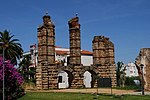Albarregas Roman bridge
Bien de Interés Cultural landmarks in the Province of BadajozBridges in Mérida, SpainHistory of ExtremaduraRoman bridges in SpainSpanish building and structure stubs

The Albarregas Roman bridge (Spanish: Puente Romano sobre El Albarregas) is a Roman bridge located in Mérida, Spain. The bridge, which is built of granite, crosses the river Albarregas, a tributary of the Guadiana. It is part of the Vía de la Plata.It has been protected since 1912. It is a Bien de Interés Cultural and part of a World Heritage Site.
Excerpt from the Wikipedia article Albarregas Roman bridge (License: CC BY-SA 3.0, Authors, Images).Albarregas Roman bridge
Calle Florencia Gil, Merida Carcesa
Geographical coordinates (GPS) Address External links Nearby Places Show on map
Geographical coordinates (GPS)
| Latitude | Longitude |
|---|---|
| N 38.923464 ° | E -6.349177 ° |
Address
Puente Romano de la Puerta (Puente del Albarregas)
Calle Florencia Gil
06800 Merida, Carcesa
Extremadura, Spain
Open on Google Maps











